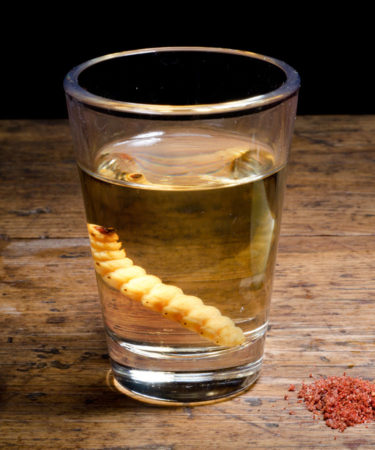In this era of craft spirits and, yes, even lawsuits about the hand-craftedness of craft spirits, it’s unlikely somebody would plunk a bottle of tequila in front of you, point at the worm floating around on the bottom, and challenge you to eat it.
Unlikely for two reasons: well, we’re all much classier these days, and thank you very much. But the second, far more important reason—there is no worm in the bottom of the tequila bottle. Not trying to invoke a “there is no spoon” vibe here, just, the tequila worm is an old school myth, a misunderstanding born of some marketing savvy and probably bolstered by the rowdy one-upsmanship of tequila swilling machismo.
Why is there a worm in tequila?
As we mentioned, a tequila worm isn’t actually a tequila worm. The worm we’re all thinking of actually belongs in a bottle of mezcal, tequila’s huskier, smokier cousin (tequila has to be at least 51% Blue Agave, but mezcal can be made from any variety of maguey succulents, the heart charred before distillation). And even then, the worm wasn’t a traditional aspect of mezcal production, even though to this day, some misinformation endures about the virility and hallucinations you’ll supposedly get as a reward for your worm-eating bravery.
The worm itself is actually a moth larvae called a gusano de maguey—since it feeds off of the maguey plant. If they weren’t being drowned in booze, each of these little guys would actually turn into a night butterfly called the Mariposa. And believe it or not, gusano de maguey are eaten, without tequila or any double-dog daring, on the regular in Mexico. In theory, if we’re digging all this virility/purity worm infusion stuff, a gusano rojo is a better worm to have in your bottle, since it feeds on the heart of the maguey (the part that’s roasted and distilled into mezcal). A gusano de oro, or gold gusano, just eats the leaves, so (yes, we’re saying this) that would be a less desirable worm to have to eat.
Who started the tequila worm craze?
Some think the worm in the bottle started as a marketing ploy, to get people to drink more mezcal in the 1940s and 1950s. Word has it a former art student-turned-mezcal entrepreneur named Jacobo Lozano Paez got the idea to actually put the gusano into the bottle of finished mezcal after realizing that the gusano changed the flavor of the spirit. (Since gusano feed on the maguey plant, it happened that sometimes a heart would be roasted with worms in it; this is, again supposedly, where Paez got the idea.)
There’s also the possibility this was purely a marketing angle, aimed at the American market. Tequila was flooding the U.S., and mezcal needed a way to differentiate itself. From here, ideas that the gusano indicated purity (a strong, pure mezcal would keep the worm intact) or could impart virility or good fortune were just a matter of some marketing imagination. Didn’t matter if Mexicans themselves never drank mezcal with a worm. We bought it, hook, line, and gusano. Even today, with mezcal making a strong, high quality comeback in the spirits world, bottles complete with a worm (and a tiny packet of worm-flavored salt) are still out there.
Meanwhile, it’s said the Normas Oficiales Mexicanas (the Mexican Standards authority) actually prohibits adding insects or larvae to tequila. So no, you’ll never see a worm at the bottom of a tequila bottle. But it’s not at all impossible you’ll encounter a worm in the bottom of a mezcal bottle. Just steer clear—the good stuff, as with many things in life, is entirely larvae-free.
